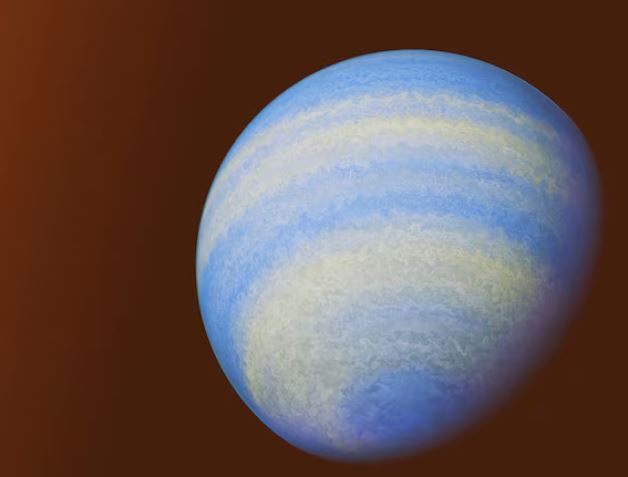A New Discovery in Exoplanetary Science
In the ever-evolving field of exoplanetary research, the planet HD 189733b has long intrigued scientists with its extreme conditions. Discovered in 2005, this gas giant, slightly larger than Jupiter, is notorious for its intense cobalt blue color and hostile environment, featuring molten glass rain that lashes sideways in violent winds. Recently, new data from the James Webb Space Telescope has added a new dimension to our understanding of this fascinating world, detecting trace amounts of hydrogen sulfide—the chemical compound responsible for the stench of rotten eggs.
Unveiling the Hydrogen Sulfide Detection
The detection of hydrogen sulfide on HD 189733b is a first for any exoplanet. Astrophysicist Guangwei Fu of Johns Hopkins University, the lead author of the study published in Nature, highlights the significance of this discovery. He explains that while this planet is far from hospitable to humans, its unique characteristics make it an invaluable subject for advancing our knowledge of planetary science. The stinky smell of hydrogen sulfide certainly adds to the planet’s infamous reputation, reinforcing its status as a hostile yet scientifically intriguing target.
Characteristics of HD 189733b
Classified as a “hot Jupiter,” HD 189733b is a gas giant similar in composition to Jupiter but significantly hotter due to its close proximity to its host star. This planet orbits its star 170 times closer than Jupiter does to the Sun, completing one orbit every two days compared to Jupiter’s 12-year orbital period. The intense proximity results in a scorching temperature of about 1,700 degrees Fahrenheit (930 degrees Celsius) on the planet’s star-facing side.
Scientific Importance of the Proximity
HD 189733b is located 64 light-years from Earth, within the constellation Vulpecula. This relatively close distance within our Milky Way galaxy makes the planet bright enough for detailed studies. According to Fu, the hydrogen sulfide detection would have been far more challenging on more distant exoplanets. The star it orbits is part of a binary system, smaller and cooler than the Sun, and only about a third as luminous.
The Role of the James Webb Space Telescope
Since becoming operational in 2022, the James Webb Space Telescope has revolutionized exoplanetary research by observing a wider wavelength range than its predecessors. This capability allows for more comprehensive examinations of exoplanet atmospheres. Arizona State University astrophysicist and study co-author Luis Welbanks notes that the new observations reveal HD 189733b to be more similar to Jupiter than previously thought, albeit much hotter.
Atmospheric Composition and Insights
In addition to hydrogen sulfide, Webb’s observations confirmed the presence of water and carbon dioxide in the planet’s atmosphere, corroborating earlier data. These three molecules—hydrogen sulfide, water, and carbon dioxide—provide crucial insights into the planet’s composition, allowing scientists to quantify the amounts of oxygen, carbon, and sulfur. This information is vital for understanding the planet’s formation and comparing it to planets within our solar system.
Absence of Methane
One notable finding from the Webb observations is the absence of methane in HD 189733b’s atmosphere. Methane, a common molecule in the atmospheres of many celestial bodies, is conspicuously missing, further distinguishing this exoplanet’s unique atmospheric chemistry.
Understanding Exoplanetary Chemistry
Welbanks emphasizes that studying the atmospheric composition of HD 189733b and other exoplanets helps scientists understand how unique our solar system is. By analyzing the chemical makeup and environmental conditions of these distant worlds, researchers can begin to piece together the “recipe” for planet formation. Although HD 189733b is far too hot and hydrogen-helium rich to support life, understanding its atmosphere provides valuable insights into the physics and chemistry operating under extreme conditions.
Conclusion: Broadening Our Cosmic Perspective
The detection of hydrogen sulfide on HD 189733b marks a significant milestone in exoplanetary science. This discovery not only enhances our understanding of this particular exoplanet but also contributes to the broader goal of contextualizing our solar system within the galaxy. As researchers continue to explore the cosmos with advanced tools like the James Webb Space Telescope, each new finding brings us closer to unraveling the mysteries of planetary formation and the diverse environments that exist beyond our solar neighborhood.

Basant Kumar Sahoo is a seasoned writer with extensive experience in crafting tech-related articles, insightful editorials, and engaging sports content. With a deep understanding of technology trends, a knack for thought-provoking commentary, and a passion for sports, Basant brings a unique blend of expertise and creativity to his writing. His work is known for its clarity, depth, and ability to connect with readers across diverse topics.



